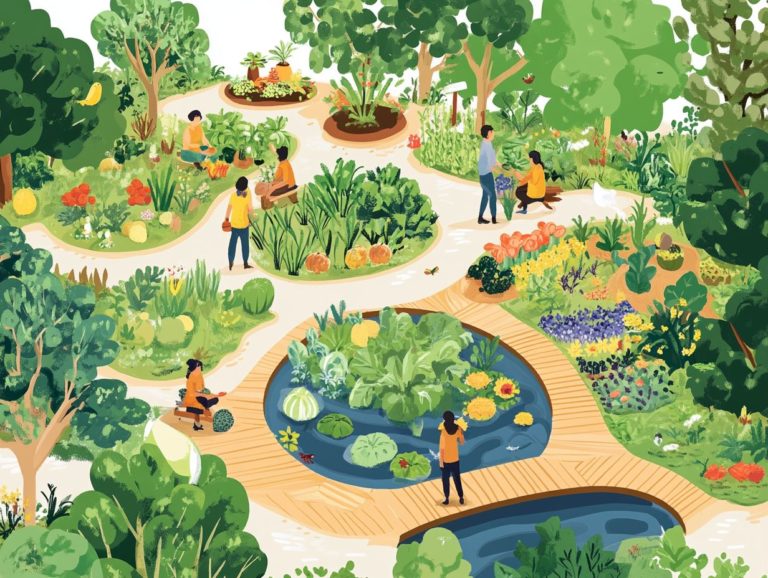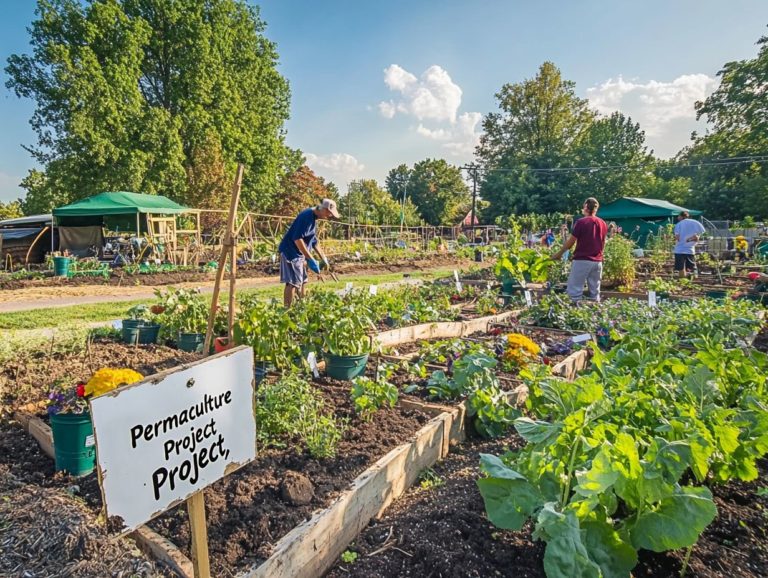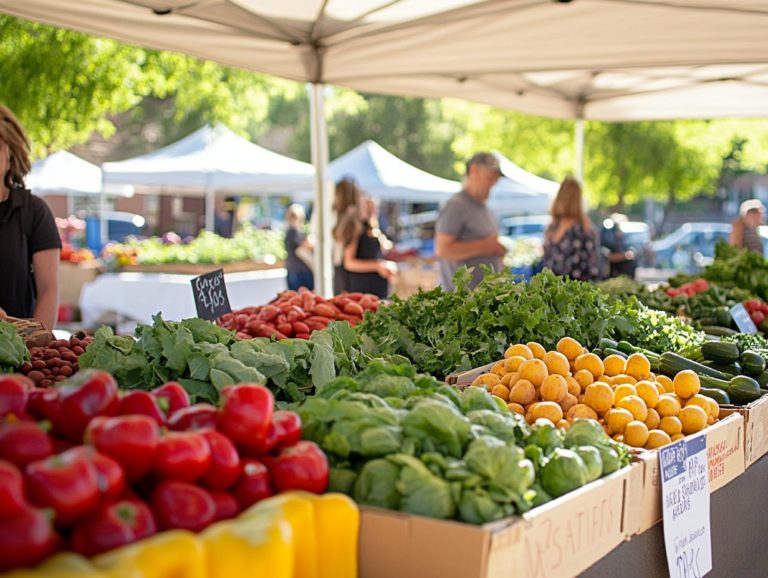57. 10 Inspiring Quotes from Permaculture Pioneers
In a world grappling with pressing environmental challenges, the principles of permaculture present a compelling vision for sustainable living. Permaculture is a system of agricultural and social design principles centered around simulating natural ecosystems.
This article showcases ten thought-provoking quotes from esteemed permaculture pioneers, each capturing the essence of harmony with nature. These insights, ranging from the significance of community cultivation to an awareness of the earth’s boundaries, can profoundly reshape your perspective on your relationship with the environment.
Prepare to be inspired and empowered to weave permaculture principles into the fabric of your daily life.
Contents
- Key Takeaways:
- 10 Inspiring Quotes from Permaculture Pioneers
- 1. “The ultimate goal of farming is not the growing of crops, but the cultivation and perfection of human beings.” – Masanobu Fukuoka
- 2. “Permaculture is a philosophy of working with, rather than against nature; of protracted and thoughtful observation rather than protracted and thoughtless labor; and of looking at plants and animals in all their functions, rather than treating any area as a single product system.” – Bill Mollison
- 3. “Permaculture is a design system for creating sustainable human environments.” – David Holmgren
- 4. “The greatest change we need to make is from consumption to production, even if on a small scale, in our own gardens. If only 10% of us do this, there is enough for everyone. Hence the futility of revolutionaries who have no gardens, who depend on the very system they attack, and who produce words and bullets, not food and shelter.” – Bill Mollison
- 5. “The aim is to create systems that function in harmony with natural processes, to produce food, shelter, and energy in a sustainable way.” – David Holmgren
- 6. “Permaculture is not a revolution, but an evolution.” – Bill Mollison
- 7. “The only ethical decision is to take responsibility for our own existence and that of our children.” – Bill Mollison
- 8. “The earth is a closed system. It can only handle so much waste and pollution before it begins to break down. We need to start designing our systems within the limits of the earth’s carrying capacity.” – David Holmgren
- 9. “The problem is the solution.” – Bill Mollison
- 10. “The aim is not to separate ourselves from nature and create a utopian environment, but to work with nature to create a sustainable and harmonious system.” – David Holmgren
- What Is Permaculture and How Does It Work?
- What Are Some Examples of Successful Permaculture Systems?
- How Can Permaculture Principles Be Applied to Everyday Life?
- What Are the Long-Term Benefits of Permaculture?
- What Are Some Common Misconceptions About Permaculture?
- Frequently Asked Questions
- Q1: What is the significance of 57 in ’57. 10 Inspiring Quotes from Permaculture Pioneers’?
- Q2: Who are considered permaculture pioneers?
- Q3: What is permaculture?
- Q4: Why are permaculture pioneers a source of inspiration?
- Q5: Can anyone practice permaculture?
- Q6: How can these quotes from permaculture pioneers inspire us?
Key Takeaways:

- Permaculture is a philosophy of working with nature to create sustainable systems.
- It is not a revolution but an evolution towards responsible and ethical living.
- By practicing permaculture, we can create a better world for ourselves and future generations.
10 Inspiring Quotes from Permaculture Pioneers
Permaculture is more than just a design philosophy; it s a transformative way to rethink your relationship with nature. It encourages you to foster sustainable systems that enrich food culture and bolster community development.
Drawing inspiration from visionary thinkers like Bill Mollison and David Holmgren, this approach emphasizes cooperation with nature, enhancing environmental health while addressing pressing issues like food security and environmental justice.
By weaving together principles from ecology, agriculture, and community planning, permaculture not only presents solutions but also inspires you and your community to build resilience against climate change and resource scarcity.
The teachings of its founders advocate for living in harmony with natural systems and biodiversity, urging you to design spaces that are not only productive but also regenerative.
As you explore these insights, you ll discover the relevance of their words in confronting today s urgent challenges, such as urban sprawl and habitat degradation. This reaffirms that sustainable living is not just a lofty ideal; it s something truly attainable and essential.
1. “The ultimate goal of farming is not the growing of crops, but the cultivation and perfection of human beings.” – Masanobu Fukuoka
Masanobu Fukuoka s perspective on farming goes beyond simply growing crops; he places the cultivation of human beings as the ultimate goal, a philosophy that resonates deeply within permaculture.
This holistic approach highlights the connection of individual well-being and ecological health, suggesting that sustainable practices can nurture both personal growth and community resilience. By advocating for methods that enrich the land while empowering local populations, this mindset becomes a catalyst for innovative solutions in community development.
It aligns seamlessly with efforts in developing regions, where fostering self-sufficiency takes precedence over dependency, enabling individuals to reclaim their dignity and agency.
Ultimately, by promoting a diverse and harmonious ecosystem, you not only enhance agricultural productivity but also cultivate thriving communities that prioritize mutual support and ecological stewardship.
Act now to integrate these principles into your life and join the movement toward sustainable living today! We encourage you to share your thoughts or take steps toward permaculture practices.
2. “Permaculture is a philosophy of working with, rather than against nature; of protracted and thoughtful observation rather than protracted and thoughtless labor; and of looking at plants and animals in all their functions, rather than treating any area as a single product system.” – Bill Mollison
Bill Mollison’s definition of permaculture invites you to cultivate a harmonious relationship with nature, championing ecological design that prioritizes thoughtful observation over mindless toil.
This philosophy transforms your perspective on agricultural practices, encouraging you to seek a balance between human needs and the intricate web of natural ecosystems. By embracing techniques like companion planting (planting different crops together to help each other grow), establishing food forests, and implementing rainwater harvesting, you can boost agricultural productivity while simultaneously enhancing local biodiversity.
Consider urban food systems that incorporate these permaculture principles. They foster resilience, reduce reliance on external food sources, and create vibrant green spaces that provide habitats for diverse species.
This shift towards sustainable practices nurtures environmental stewardship and addresses food security. It ultimately creates a win-win scenario for both people and the planet.
3. “Permaculture is a design system for creating sustainable human environments.” – David Holmgren
David Holmgren presents permaculture as a transformative design system aimed at creating sustainable human environments, marking a vital shift in your approach to ecological sustainability.
By embracing this overall approach, he broadens the scope of permaculture principles well beyond traditional agricultural methods. This perspective helps build community development, allowing you and your neighbors to collaborate on enhancing living conditions and strengthening social bonds.
Urban renewal projects can greatly benefit from permaculture strategies advocating for green spaces, efficient waste management, and local food systems. You ll find that energy efficiency is woven into these ecological frameworks, promoting renewable energy sources while reducing dependence on fossil fuels.
This comprehensive application supports thriving urban ecosystems and builds resilience within communities grappling with environmental challenges.
4. “The greatest change we need to make is from consumption to production, even if on a small scale, in our own gardens. If only 10% of us do this, there is enough for everyone. Hence the futility of revolutionaries who have no gardens, who depend on the very system they attack, and who produce words and bullets, not food and shelter.” – Bill Mollison
Bill Mollison presents a transformative view on agriculture, encouraging you to shift your focus from mere consumption to active production a concept that lies at the heart of permaculture’s philosophy.
This shift is vital for boosting food security and tackling today s alarming levels of wasteful consumption.
By emphasizing small-scale production, you can help your community become more self-sufficient, ensuring that local needs are met sustainably. This approach not only fortifies resilience against the ups and downs of global markets but also gives you the power to take control of your food sources.
Such initiatives can significantly support relief efforts in developing countries, as locally grown food helps alleviate hunger and improve nutrition. Start embracing these principles today to make a real difference in your community!
How can you start your garden to shift from consumption to production? By doing so, you contribute to the flourishing of your community while playing a part in creating a more sustainable and equitable world.
5. “The aim is to create systems that function in harmony with natural processes, to produce food, shelter, and energy in a sustainable way.” – David Holmgren
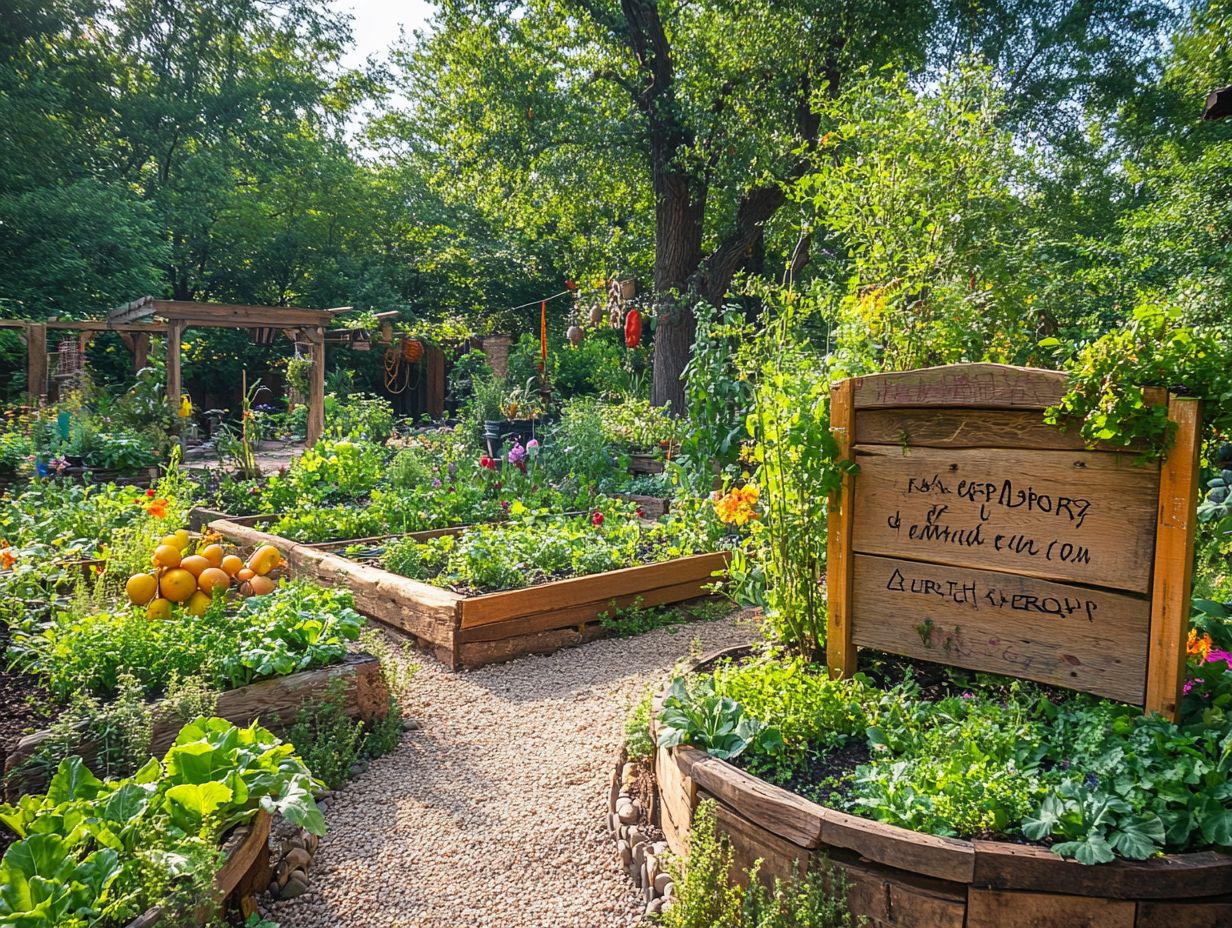
David Holmgren highlights the significance of crafting systems that align with natural processes, a key idea in permaculture.
You can apply this core principle to various ecological designs, especially in urban food systems and energy-efficient infrastructures.
By integrating these designs, your community can cultivate local food sources that flourish alongside natural ecosystems. This enhances biodiversity and promotes self-sufficiency.
Emphasizing energy efficiency through the use of natural materials and sustainable technologies minimizes carbon footprints and nurtures a harmonious relationship with the environment.
This collaborative approach gives the power to urban planners and designers to establish resilient habitats. Here, the synergy between human activity and nature becomes a driving force for enduring sustainability.
6. “Permaculture is not a revolution, but an evolution.” – Bill Mollison
Bill Mollison’s statement positions permaculture not as a sudden upheaval, but as an evolution in your relationship with ecological systems.
This gradual transformation reflects a deeper understanding of the intricate connections between agriculture and the environment.
As you embrace permaculture principles, you cultivate crops and build community awareness about sustainable practices.
This shift resonates with broader societal movements advocating for environmental justice. It recognizes that healthy ecosystems are foundational to social equity.
By integrating sustainable agriculture into local food systems, you pave the way for a cultural renaissance. Here, food choices become acts of stewardship, directly influencing gardening techniques and policy decisions.
7. “The only ethical decision is to take responsibility for our own existence and that of our children.” – Bill Mollison
Bill Mollison emphasizes the ethical responsibility for your existence and that of future generations. This theme resonates deeply within the guiding principles of permaculture.
This perspective sparks a strong sense of stewardship and ignites transformative community development initiatives linked to ecological sustainability.
By prioritizing local resources and embracing collaborative decision-making, you empower your community to create projects that meet both social and environmental needs.
Community gardens, for example, become vibrant hubs for education, resilience, and food security, embodying this philosophy in action.
Initiatives focused on rainwater harvesting and renewable energy cooperatives illustrate how adopting these ethical principles can lead to self-sufficient systems that serve both people and the planet.
8. “The earth is a closed system. It can only handle so much waste and pollution before it begins to break down. We need to start designing our systems within the limits of the earth’s carrying capacity.” – David Holmgren
David Holmgren s assertion about Earth being a closed system underscores the pressing need to design ecological systems that honor the planet s limits a fundamental principle of permaculture.
Now is the time to pivot your focus toward innovative solutions that foster sustainable agriculture and effective waste management practices.
This mindset invites local farmers to embrace regenerative techniques, such as crop rotation and polyculture. These methods bolster soil health and lessen reliance on chemical inputs.
Implementing waste management strategies like composting and recycling can dramatically reduce pollution. This leads to healthier ecosystems.
By engaging communities in education about energy-efficient practices like harnessing renewable resources and enhancing transportation methods you’ll contribute to a collective effort dedicated to environmental protection and ensuring food security for future generations.
9. “The problem is the solution.” – Bill Mollison
Bill Mollison s adage, The problem is the solution, perfectly captures the brilliance of permaculture in harnessing ecological systems to tackle challenges.
This philosophy invites you to think creatively about sustainability, turning obstacles into opportunities. For example, consider community development: wasted food can be transformed into decomposed organic material, enriching soil health and leading to stronger crops.
In agriculture, you can address water scarcity by implementing rainwater harvesting systems, rejuvenating the landscape while ensuring your plants receive the irrigation they need.
By viewing these challenges through the lens of permaculture, you can cultivate resilient ecosystems that not only address immediate issues but also foster long-term sustainability within your community.
10. “The aim is not to separate ourselves from nature and create a utopian environment, but to work with nature to create a sustainable and harmonious system.” – David Holmgren
David Holmgren emphasizes that your ultimate aim in permaculture should be to work with nature, rather than seeking to escape from it. This strategy creates a thriving and balanced environment.
This philosophy highlights the importance of ecological design, which acts as a vital bridge to maintaining balance within your ecosystems. By observing and mimicking natural processes, you can create environments that not only meet human needs but also enhance biodiversity.
Consider the successful examples of Miyawaki forests dense plantings using native species that restore local ecosystems in Japan, or the forest gardens of the tropics, where layers of plants interact symbiotically to provide food, habitat, and resilience. These groundbreaking initiatives demonstrate the incredible potential of working with nature, allowing communities to flourish and landscapes to become more resilient.
What Is Permaculture and How Does It Work?
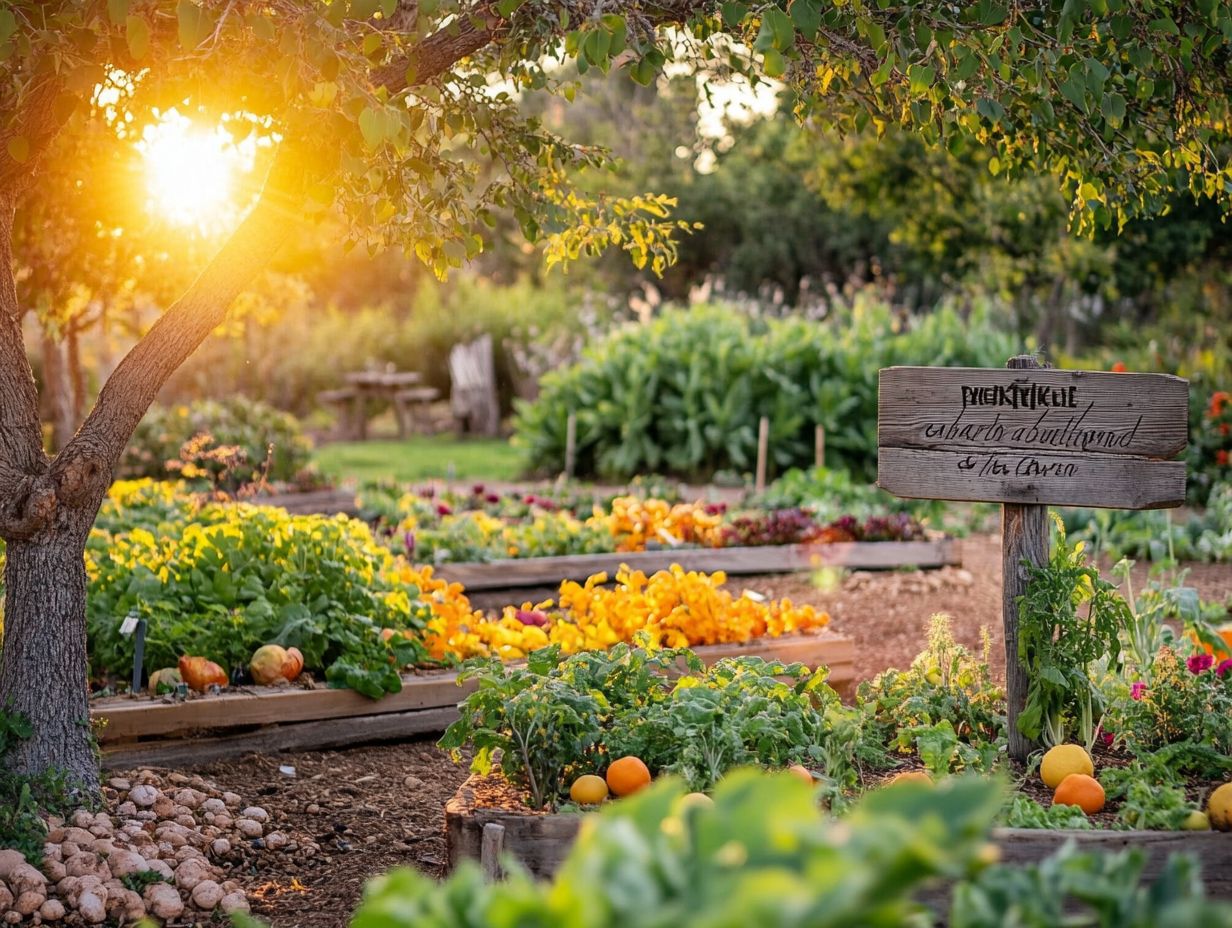
Permaculture offers you an innovative framework for crafting sustainable systems that align seamlessly with natural ecosystems, addressing the needs of your community while championing ecological sustainability.
At its essence, permaculture revolves around two fundamental principles: the care of Earth and the care of people. These guiding tenets act as your compass throughout the design process, ensuring that your agricultural practices not only foster environmental health but also enhance the well-being of local communities.
By integrating diverse elements such as food production, waste management, and resource conservation this approach helps you cultivate resilience and efficiency. These principles hold particular significance in third-world relief efforts, empowering communities to achieve self-sufficiency and flourish in harmony with their environment.
Who Are Some of the Key Figures in the Permaculture Movement?
The permaculture movement has been profoundly shaped by influential figures like Bill Mollison and David Holmgren, whose groundbreaking contributions have impacted sustainable systems globally.
You ll find that other key players, such as Geoff Lawton, have been instrumental in advancing permaculture practices through dynamic educational initiatives and hands-on workshops around the world. His unwavering commitment to regenerative agriculture inspires a new generation to rethink their land management strategies.
Meanwhile, Caroline Smith has been a trailblazer in environmental justice, championing policies that foster sustainable communities while addressing vital issues of equity and resource access.
Collectively, these leaders have enriched the permaculture narrative, fostering a more inclusive dialogue about sustainability and its far-reaching effects on both local and global scales.
Join the movement today to create lasting change in your community!
What Are Some Examples of Successful Permaculture Systems?
Successful permaculture systems exemplify the principles of a variety of plants and animals and ecological sustainability. They showcase innovative approaches to community development and farming that works with nature.
Take, for instance, the remarkable work being done in the community gardens of Havana, Cuba. Here, urban permaculture transforms abandoned spaces into vibrant ecosystems! These efforts nourish the local populace while fostering social cohesion.
Similarly, consider the permaculture initiatives on the outskirts of Graz, Austria. These efforts focus on water management and soil regeneration. They allow diverse crops to flourish and enhance the well-being of surrounding communities.
These examples illustrate the adaptability of permaculture to local conditions. They address both environmental and economic challenges, leading to resilient food systems that empower communities.
How Can Permaculture Principles Be Applied to Everyday Life?
Applying permaculture principles to your everyday life empowers you to transform your surroundings into sustainable systems that embody a deeper connection with nature.
Start growing your own fresh, organic produce today! By creating urban gardens in any available space be it a small balcony or a community lot you can cultivate while minimizing resource waste.
Reducing traditional lawn culture opens up room for diverse plant life and encourages local biodiversity, which is a win-win. Incorporating native plants, which are those that naturally grow in your area, and edible landscaping enhances the aesthetic appeal of your environment.
These practices foster interactions among community members, creating a supportive network for knowledge sharing. They yield healthier produce and contribute to the broader ecological health of your area, promoting sustainability and resilience against climate change.
What Are the Long-Term Benefits of Permaculture?
The long-term benefits of permaculture extend far beyond your individual garden. This approach champions ecological sustainability, enhanced food security, and resilient community development.
When implemented effectively, you foster improvements in local biodiversity by creating habitats that support a rich tapestry of flora and fauna. It encourages community cooperation, bringing people together to share resources, knowledge, and labor, reinforcing social bonds.
By practicing mindful resource management, you reduce wasteful consumption and prompt both communities and individuals to rethink their ecological footprint. Ultimately, this sets off a ripple effect that can inspire policy changes and pave the way for a more sustainable future for generations to come.
What Are Some Common Misconceptions About Permaculture?
Despite its increasing popularity, several misconceptions about permaculture continue to linger. These often overshadow its true potential as a framework for sustainable systems and ecological design.
You might think it s just about gardening techniques, but in reality, permaculture represents a holistic approach that seamlessly integrates agricultural practices with social equity and community engagement. Its primary goal is to cultivate resilient ecosystems that benefit both the environment and the people living within them.
Evidence demonstrates that communities embracing permaculture principles enhance local biodiversity and tackle social disparities. They provide access to fresh food and foster economic independence, empowering residents to take an active role in their environment.
By moving beyond simplistic interpretations, you can see how permaculture serves as a catalyst for environmental justice. Join the movement and start your permaculture journey today!
Frequently Asked Questions
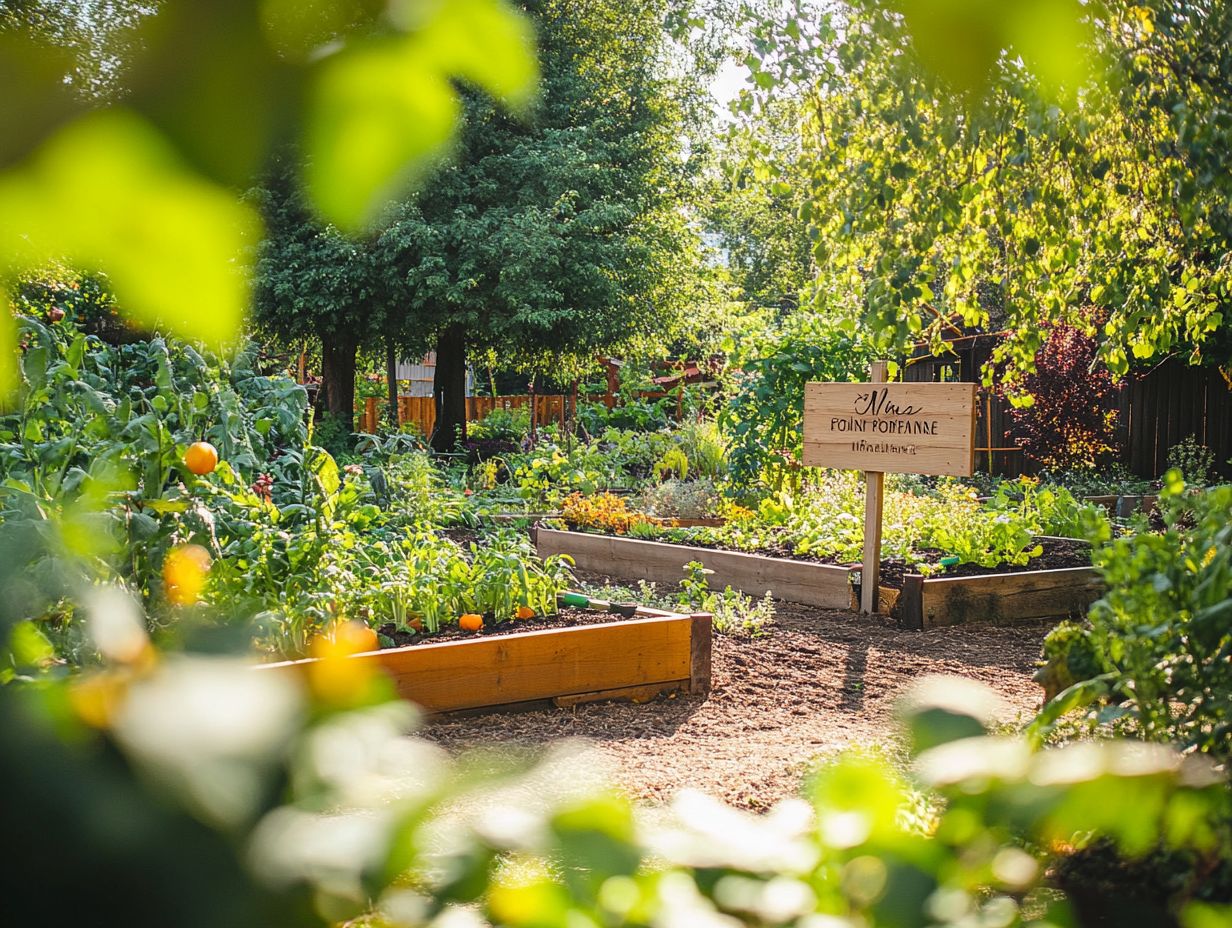
Explore these inspiring quotes that highlight the wisdom of permaculture pioneers.
Q1: What is the significance of 57 in ’57. 10 Inspiring Quotes from Permaculture Pioneers’?
A1: The number 57 signifies the total quotes from permaculture pioneers featured in this topic. These quotes come from influential figures like Geoff Lawton, Masanobu Fukuoka, and Paul Hawken, showcasing their contributions to sustainable practices.
Q2: Who are considered permaculture pioneers?
A2: Permaculture pioneers are individuals who significantly contribute to permaculture principles and practices. Notable names include Sharon Weil and Thomas Berry, who inspire many through their work.
Q3: What is permaculture?
A3: Permaculture is an ecological design system that creates sustainable and self-sufficient habitats. It follows the patterns of nature to ensure balance and harmony.
Q4: Why are permaculture pioneers a source of inspiration?
A4: These pioneers dedicate their lives to sustainable living practices. Their knowledge and insights inspire us to create a more sustainable world.
Q5: Can anyone practice permaculture?
A5: Yes, anyone can practice permaculture, regardless of background or location. It adapts to various environments and lifestyles, similar to training courses available for learning.
Q6: How can these quotes from permaculture pioneers inspire us?
A6: These quotes share wisdom from those living in harmony with nature. They encourage us to take action and make positive changes in our lives and communities.

